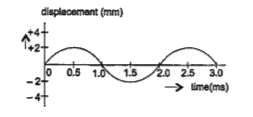Assertion: Standing waves are formed when amplitudes of two constituent waves are equal.
Reason: At any point net displacement at a given time is resultant of displacement of constituent waves.
If both Assertion and Reason are true and the Reason is correct explanation of the Assertion.
If both Assertion and Reason are true but Reason is not the correct explanation of Assertion.
If Assertion is true, but the Reason is false.
If Assertion is false but the Reason is true.
The correct Answer is:D
Amplitudes may be different also.
Topper's Solved these Questions
- BOOK - DC PANDEYCHAPTER - SUPERPOSITION OF WAVESEXERCISE - Level 1 Objective11videos
SUPERPOSITION OF WAVES
- BOOK - DC PANDEYCHAPTER - SUPERPOSITION OF WAVESEXERCISE - Objective Questions1videos
SUPERPOSITION OF WAVES
- BOOK - DC PANDEYCHAPTER - SUPERPOSITION OF WAVESEXERCISE - Exercise 18.43videos
SUPERPOSITION OF WAVES
- BOOK - DC PANDEYCHAPTER - SOUND WAVESEXERCISE - Exercise 19.74videos
SOUND WAVES
- BOOK - DC PANDEYCHAPTER - THERMOMETRY THERMAL EXPANSION AND KINETIC THEORY OF GASESEXERCISE - Medical entrance gallary30videos
THERMOMETRY THERMAL EXPANSION AND KINETIC THEORY OF GASES
Similar Questions
A series of pulses, each of amplitude 0.150m, are sent on a string that is attached to a wall at one end. The pulses are reflected at the wall and travel back along the string without loss of amplitude. When two waves are present on the same string. The net displacement of a given point is the sum of the displacement of the individuals waves at the point. What is the net displacement at point on the spring where two pulses am crossing, (a) if the string is rigidly attached to the post? (b) if the end at which reflection occurs is free is slide up and down ?
View Solutionshow that when reflection takes place from a boundary separating two media and the velocity in the second medium is infinitely large , the amplitude of the reflected wave is equal to the amplitude of the incident wave and there is a phase change of π in the displacement wave.
View Solution
Knowledge Check
- Question 1 - Select One
Assertion: Three waves of equal amplitudes interfere at a point. Phase difference between two successive waves is π2. Then, resultant intensity is same as the intensity due to individual wave.
Reason: Two different light sources are never coherent.AIf both Assertion and Reason are true and the Reason is correct explanation of the Assertion.BIf both Assertion and Reason are true but Reason is not the correct explanation of Assertion.CIf Assertion is true, but the Reason is false.DIf Assertion is false but the Reason is true. - Question 2 - Select One
A standing wave arises on a string when two waves of equal amplitude , frequency and wavelength travelling in opposite superimose. If the frequency of oscillation of the standing waves
Agets doubledBgets halvedCremains unchangedDchanges but not by a factor of 2or1/2 - Question 3 - Select One
Assertion: Stationary waves are so called because particles are at rest in stationary waves.
Reason: They are formed by the superposition of two identical waves travelling in opposite directions.AIf both Assertion and Reason are true and the Reason is correct explanation of the Assertion.BIf both Assertion and Reason are true but Reason is not the correct explanation of Assertion.CIf Assertion is true, but the Reason is false.DIf Assertion is false but the Reason is true.
Consider two waves passing through the same string. Principle of superposition for displacement says that the net displacement of a particle on the string is sum of the displacements produced by the two waves individually. Suppose we state similar principles for the net velocity of the particle and the net kinetic energy of the particle. Such a principle willl be valid for
View SolutionA stationary wave is formed by superposition of two constituent waves, having amplitude, frequency and velocity as 10 cm, 40 Hz and 200 cm/s, respectively. Write the equation of the stationary wave.
View SolutionTwo waves of amplitudes 3mmand2mm reach a point in the same phase. What is the resultant amplitude ?
View SolutionAssertion: If two waves of same amplitude produce a resultant wave of same amplitude,then the phase difference between them will be 120∘
Reason: The resultant amplitude of two waves is equal to vector sum of amplitudes treated as vectorsView SolutionThe figure shows displacement time graph of a wave. The frequency of this wave is displacement (mm)
 View Solution
View Solution

